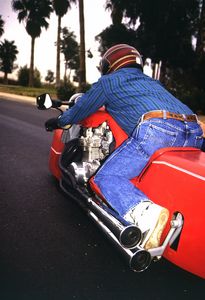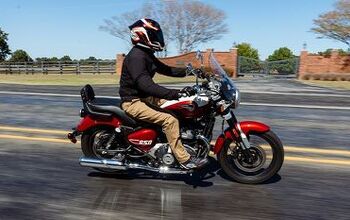The Flying Red Chair
Tom Ridyard always liked things with wings.
An aircraft inspector by profession, he also enjoyed fabricating alternate winged means of alternate transportation. Several years ago the Phoenix, Arizona resident managed to build a Cessna 150 in his backyard from spare parts, and then took on another lower to the ground project, this one-of-a kind sidecar.
Sidehacks or "chairs" as they are called were a very popular form of transportation both in Europe and the United States during the early 1900's because they were less expensive to purchase and maintain than automobiles. Today sidecar racing in the U.S. is not the sensation it is in England and on the Continent, so Tom could be considered a member of the "fringe element" of American motorcycling.
Later he built a variety of street and racing sidecars and began competing in both dirt track and roadracing sidecar events including seven years as a "monkey" or passenger. He even won the Ascot TI (L.A. version), raced in sidecar motocross, and competed at Laguna Seca, Sears Point, Riverside Raceway and the Long Beach Gran Prix among other events. Tom goes way back in the sport, a member of the Los Angeles Sidehack Association which was formed about 40 years ago by the Galloping Gooses, a motorcycle club. Tom remembers seeing fellow members Keenan Wynn and Lee Marvin race off-road sidecars at Lake Elsinore, Hopetown and Barstow to Vegas.
"Riding as a passenger is similar to flying in an open cockpit ultra-light aircraft, except the ground is a lot closer, about four inches away."
Tom makes it sound it easy, but sidecar riding, not to mention sidecar racing, takes some very different turns than the two-wheeled kind.He built and raced at various times machines powered by Harley, Yamaha, Honda and Kawasaki engines. He was having such a blast that he embarked on several trips to Europe where he toured the sidecar racing circuit in Sweden, Denmark, Germany, France, Belgium and Holland where he gained valuable experience competing aboard a Honda 750 "chair" battling Europe's leading superstars.
Nowadays, thanks to such individuals as sidecar guru Doug Bingham of Side Striders, Inc., more and more sidecars can be spotted, but nary a "kneeler" such as Tom's Kawasaki powered version. Tom rides his sidecar in a semi-prone kneeling position in the fashion of the competition models. Meanwhile his passenger, on those commutes to the work sits in an upright position in an upholstered bucket seat. In its original form, the passenger also sat in a prone position, but that proved fairly uncomfortable since the sidecar has no suspension on the chair side so Tom made the necessary modifications. "Riding as a passenger is similar to flying in an open cockpit ultra-light aircraft, except the ground is a lot closer, about four inches away."
Since the front end steering geometry includes a trail of only a half-inch (similar to a bicycle's geometry) and while most street bikes are 3-4 inches, Tom's machine provides easy and very responsive steering. "It feels much like steering a bicycle," says Tom. "Just sneeze and you change lanes." Tom makes it sound it easy, but sidecar riding, not to mention sidecar racing, takes some very different turns than the two-wheeled kind.
Tom calculated in the weight and placement of the disc brake, the battery and 20 lbs. of lead "ballast" (underneath a cover in the forward corner of the rig) all of which affects the sidecar's handling characteristics. Going around corners is accomplished by coordinating the throttle and the brakes. Tom's explains the technique involved: "If you're going into a right hand turn, the chair on the right, you scruff off the excess speed before you hit the apex. That way when you reach the apex, you can accelerate out and keep the chair down. If you have a passenger, he hangs it out at the apex and makes the bike do its turn, then the bike can accelerate in a straight line. You've made a straight line out of it, and not lost much momentum."
He was having such a blast that he embarked on several trips to Europe where he toured the sidecar racing circuit in Sweden, Denmark, Germany, France, Belgium and Holland.
"A left hand turn is handled by literally throwing the bike into the turn to scruff off its speed. Then you use the front brake to bring the front end around. When you accelerate out of the turn, you'll have to compensate because you'll be understeering the front end unless you have a really well balanced bike or the passenger makes his move by getting up over the bike, putting his weight not only over the rear wheel but forward to match yours." Needless to say, Tom's many years of competition, both on paved and dirt courses, has served in good stead for handling the demands of freeway travel.
Tom carefully researched the safety and legal requirements before building his creation to make sure it would pass the necessary inspections for streetability. The State of Arizona Motor Vehicle Department did take three days to make up their mind grumbling that it was "unsafe, dangerous, would scare people and was red to boot," but Tom was granted permission to legally display the commuter lane permit allowing him to ride in the car pool lane since he often carries a passenger. Tom recalls that he did attract the attention of the local constabulary who tended to take his presence without too much alarm after the initial shock passes.
More by Paul Garson


































Comments
Join the conversation